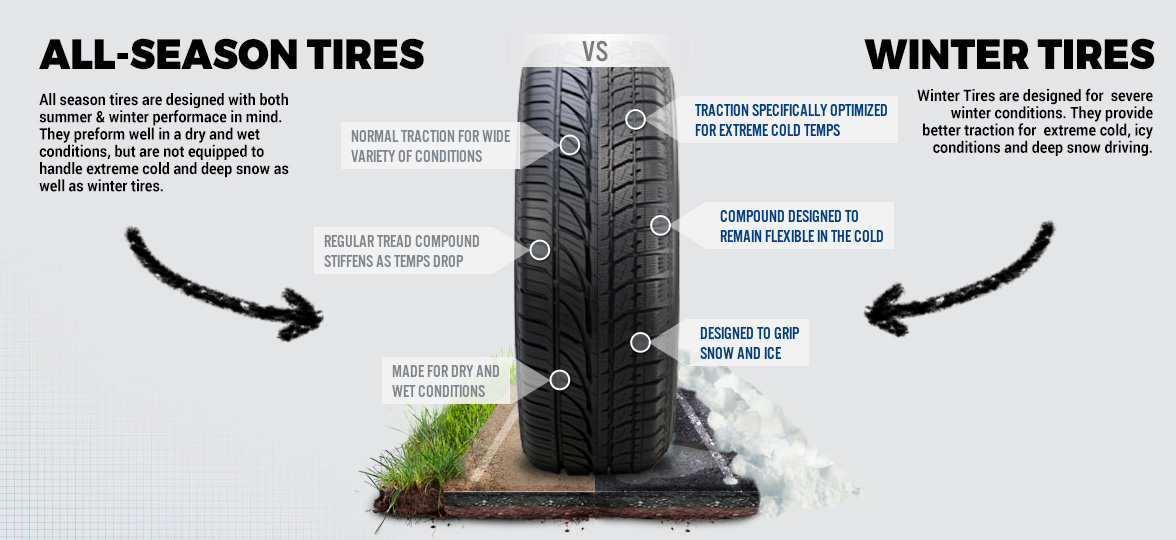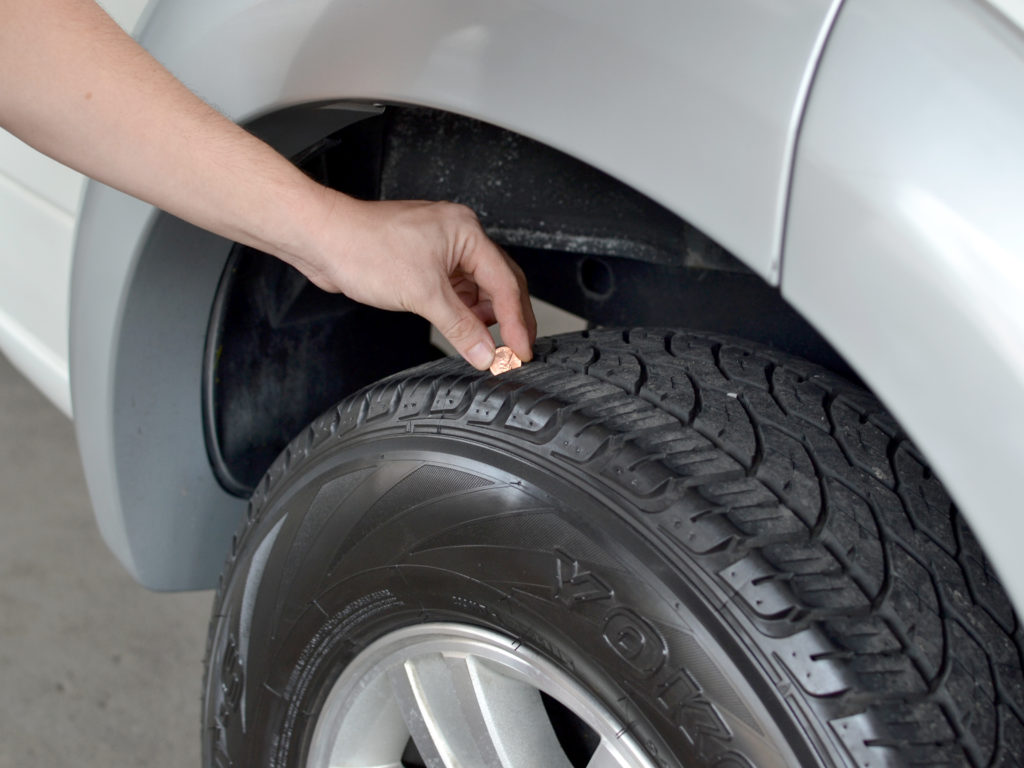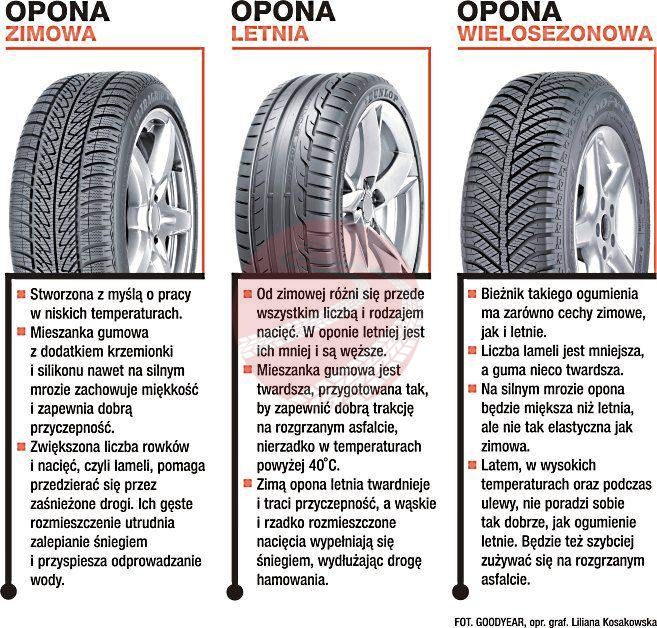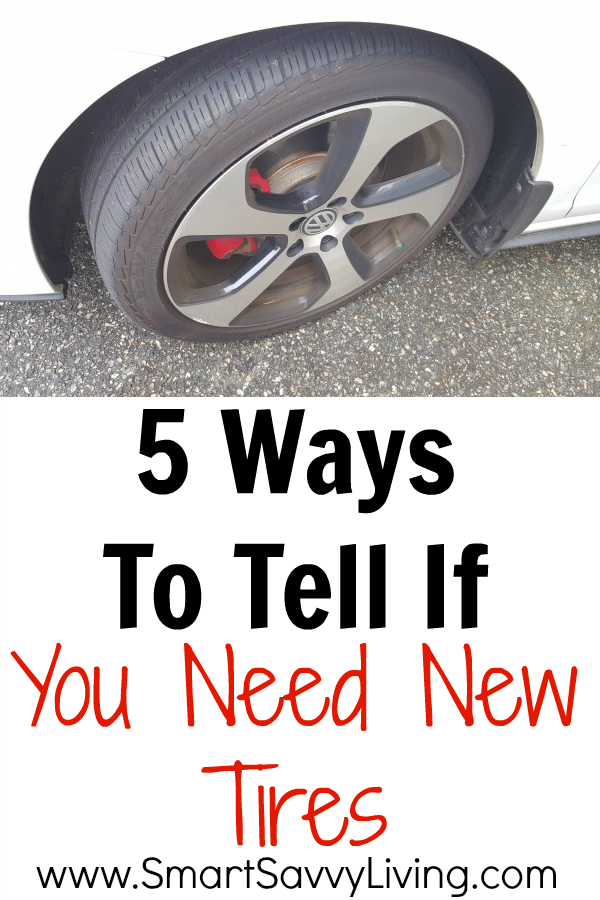If you have recently bought a vehicle, or you have been driving your car or truck for a while but haven’t thought to check out what kind of tires you have, you may be wondering how to figure out what your vehicle is fitted with.
There are many different kinds of tires, and each has been designed for a different driving purpose, and for differing conditions. One main differentiating factor in tire type is what weather conditions it has been designed for – winter, summer, or all seasons.
If you are unsure what kind of tires are on your vehicle, then read on, as we have some quick and easy ways to help you identify them different types of tires, which is especially important if you are planning on buying new ones.
Fairly easy to identify, winter tires always have a pictogram with a snowflake and mountains on their sidewall. This symbol - called 3PMSF for Three Peak Mountain Snowflake - means that the tire meets international standards for use in harsh winter conditions, making it a safe and reliable tire for anyone who drives in snowy, slippery, and extremely cold conditions. The tread depth of a winter tire is always at least 4 mm, to ensure a longer life in severe winter conditions.
If you are curious about the optimum outdoor temperature range for winter tires, generally, this value is related directly to the rubber compounds used in their manufacturing. If they bear the three-peaked mountain and snowflake logo, it means these winter tires have been tested in winter conditions under 40 degrees Fahrenheit. While this might seem extreme, temperatures this cold do occur in parts of Canada from time to time. Regular winter tires marked with the M+S logo should be installed when the weather dips under 7 °C, or sooner if snow and ice start falling in your region.
If you are wondering if you have summer tires installed on your vehicle, there are a few features you can used to identify them. Summer tires are not quite as common as say, all-season tires, and tend to be found installed on high performance vehicles such as sports cars, or cars used solely during the summer months, such as vintage cars. Other features of summer tires include:
As you have read, summer tires are best suited for warm weather driving, but you may have questions about what the ideal summer tires temperature range might be. The suggested temperature range for summer tires
is when the weather hits above 45 °F or 7 degrees Celsius. In most parts of Canada, this means that summer tires are best installed near the end of the spring season, or at the beginning of summer – and are taken off and replaced with your all-season tires at the beginning of fall, still depending, of course, on where you live.
The suggested temperature range for summer tires
is when the weather hits above 45 °F or 7 degrees Celsius. In most parts of Canada, this means that summer tires are best installed near the end of the spring season, or at the beginning of summer – and are taken off and replaced with your all-season tires at the beginning of fall, still depending, of course, on where you live.
One of the most popular types of tires is the all-season tire. If you are wondering if those are the ones equipped on your vehicle, then here are a few features to look for:
Because they are called all season, these types of tires can be used all year round, as long as you are driving in average conditions. However, if you want to know the temperature range for all-season tires, you should install them when the temperature is between 30 °F and around the freezing mark in Canada of 0 degrees Celsius. These tires will perform well during the winter months, but if you live in a region where you get a lot of snow and ice, or you travel on less well-kept roadways, then you may want to think of putting winter tires on your vehicle when the snowy season begins.
However, if you want to know the temperature range for all-season tires, you should install them when the temperature is between 30 °F and around the freezing mark in Canada of 0 degrees Celsius. These tires will perform well during the winter months, but if you live in a region where you get a lot of snow and ice, or you travel on less well-kept roadways, then you may want to think of putting winter tires on your vehicle when the snowy season begins.
Of course, if you have any questions about what kind of tires to install on your vehicle, or need additional help determining what kind of tires you currently have on your car or truck, it’s best to reach out to a team of tire experts, like the people at blackcircles.ca. Our team is available to answer all your questions on tires, and we can also help find the perfect set of new tires at the best prices in Canada. Just reach out to us by email, phone or use our online chat, and we will be happy to help you out.
discover our best 2021 summer and all season tires
There are two common grading systems for tires to help identify winter tire traction capabilities. All tires that pass certain winter tire traction tests can be marked with a symbol molded onto the side of the tire. One is the M+S (mud and snow) symbol, and the second is the mountain/snowflake symbol. Both are based on standardized tire industry testing, however the extent of testing, and the traction levels required to qualify for each symbol are very different. While both symbols are helpful indictors of what you can expect from the tire, it is important to understand the difference between the two. This is particularly important when deciding on which tires to purchase for your car, SUV, CUV or light truck in colder climates.
M+S symbol usually found on the side of the tire near the wheel flange
The M+S tire marking system was first introduced to differentiate knobby bias-ply tires from the more common rib treads on early radial car and light truck tires. Over time, M+S became a standard marking to show the tire had some “all-season” capability compared to summer tires. Unfortunately, it is a very one-dimensional test in that it only measures traction in packed snow and mud. It does not measure traction on ice, slush or traction on cold dry roads. For that reason the M+S Symbol falls short in helping fully evaluate winter tire performance expectations in winter driving conditions.
Over time, M+S became a standard marking to show the tire had some “all-season” capability compared to summer tires. Unfortunately, it is a very one-dimensional test in that it only measures traction in packed snow and mud. It does not measure traction on ice, slush or traction on cold dry roads. For that reason the M+S Symbol falls short in helping fully evaluate winter tire performance expectations in winter driving conditions.
Three Peak Mountain Snowflake symbol is on many Winter Tires.
Recognizing a need for a more up-to-date and helpful measurement of true winter performance, as well as a way to differentiate all-season tires from winter tires, the Rubber Manufacturers Association (RMA) came up with the Mountain/Snowflake symbol for tires. When you see this icon on the sidewall of your tire, you can be assured it meets more stringent winter traction performance requirements and has been rated for “severe snow service”. This includes snowy, slippery roads and low temperature or freezing roads. Most all-season tires do not qualify for the Mountain/Snowflake symbol because the tread rubber in all-season and summer tires become hard at temperatures below 40 F. Only dedicated winter tires, select all-terrain light truck and SUV tires, and some of the latest generation “all-weather tires” meet the traction qualifications for the Mountain/Snowflake symbol’s severe snow service rating. One “all-weather” tire with the Mountain/Snowflake symbol is the Nokian WR G3 tire. The Nokian WR G3 are tires that you can leave on the vehicle all-year round, and still be assured of good traction in winter conditions other than just light snow. Nokian also makes a full line of winter tires for all vehicles and their new Hakkapeliitta 9 studded tire is a great choice for severe weather conditions.
This includes snowy, slippery roads and low temperature or freezing roads. Most all-season tires do not qualify for the Mountain/Snowflake symbol because the tread rubber in all-season and summer tires become hard at temperatures below 40 F. Only dedicated winter tires, select all-terrain light truck and SUV tires, and some of the latest generation “all-weather tires” meet the traction qualifications for the Mountain/Snowflake symbol’s severe snow service rating. One “all-weather” tire with the Mountain/Snowflake symbol is the Nokian WR G3 tire. The Nokian WR G3 are tires that you can leave on the vehicle all-year round, and still be assured of good traction in winter conditions other than just light snow. Nokian also makes a full line of winter tires for all vehicles and their new Hakkapeliitta 9 studded tire is a great choice for severe weather conditions.
At this time, there are only a few areas in North America were winter tires are mandatory. In some Canadian provinces, only tires bearing the Mountain/Snowflake symbol are considered acceptable winter/snow tires, and by law must be used from October through March. Winter tire usage laws are under consideration for some northern U.S. states as well, but for the time-being, good all-season tires that carry the M+S symbol continue to be the broader definition for the minimum acceptable levels of winter traction. M+S rated tires or snow chains are usually permitted in mountain passes and other areas under winter weather advisory conditions.
In some Canadian provinces, only tires bearing the Mountain/Snowflake symbol are considered acceptable winter/snow tires, and by law must be used from October through March. Winter tire usage laws are under consideration for some northern U.S. states as well, but for the time-being, good all-season tires that carry the M+S symbol continue to be the broader definition for the minimum acceptable levels of winter traction. M+S rated tires or snow chains are usually permitted in mountain passes and other areas under winter weather advisory conditions.
Regardless of the local laws and regulations, winter tires are proven to increase safety and reduce accidents if you regularly drive in snow, slush, ice, or cold conditions, or live in an area that regularly experiences winter temperatures below 45 degrees. Visit Tires-easy.com to find all your winter/snow tire needs or check out another helpful post, How to Buy Tires Online: A Complete Guide.
Join Today For Free
The right choice of car wheels will allow you to move in comfort and safety. Rubber must strictly correspond to the season, road and temperature conditions. Incorrect use of wheels significantly increases the braking distance, the service life of the wheels, and the economy of movement. It is not surprising that manufacturers produce summer and winter tires, and today universal all-season tires are becoming especially popular. It is worth figuring out how to distinguish winter tires from summer tires, and for this you need to study the main characteristics of the wheels.
Rubber must strictly correspond to the season, road and temperature conditions. Incorrect use of wheels significantly increases the braking distance, the service life of the wheels, and the economy of movement. It is not surprising that manufacturers produce summer and winter tires, and today universal all-season tires are becoming especially popular. It is worth figuring out how to distinguish winter tires from summer tires, and for this you need to study the main characteristics of the wheels.
Tires for the cold season are distinguished by a carved and deep tread pattern, which can look like a familiar “herringbone” or chaotic depressions. Lamellas or zigzag cuts on the tread are the virtues of winter tires. It is they, as well as checkers and deep grooves, that provide effective removal of snow and water, increase the coefficient of adhesion on the road. There are two main types of tread pattern for winter:
Scandinavian - the pattern is sparse, the checkers are staggered and look like rhombuses, there is a noticeable distance between the elements of the pattern;
European - the pattern is located diagonally, the network of channels is well developed, powerful lugs are located on the periphery of the tread, there are a large number of thin slots - lamellas on the surface.
Summer tires have shallow tread grooves designed to expel water, the number of sipes is kept to a minimum. There is no micro-pattern in the wheels for summer.
Spikes are another criterion of seasonality. There are no summer studded tires, and winter studding should be chosen carefully. The studs are designed for driving on ice, providing good grip where other wheels slip. They should not be located in two rows on the sides of the tires - this will not shorten the braking distance at all, and the spikes themselves will fly out after several trips. High-quality studding suggests an asymmetric or snake-like arrangement of spikes.
In addition, rubber for winter tires is softer and more elastic, it is visible to the naked eye for an experienced driver. This is easy to determine even by touch, since there is an order of magnitude more rubber in the rubber compound, which allows the tires not to freeze at low temperatures. Summer tires, on the contrary, are more elastic - there is less rubber in them, because in the heat soft tires “float” and do not hold the road. For safety reasons, summer tires are resistant to wear and high temperatures.
For safety reasons, summer tires are resistant to wear and high temperatures.
During operation, winter tires warm up and therefore do not lose their elasticity and softness. On winter snowy or icy roads, this provides maximum grip, effectively shortening the braking distance. Summer tires cool down at speed, becoming more shaped and firm.
An important quality of rubber, which makes it possible to distinguish between summer and winter tires, is the maximum permissible speed. In winter, even on the highest quality roads, it is not recommended to drive faster than 140 km / h; summer tires are more democratic in this matter.
Despite everything, even a novice driver will be able to determine the seasonality of tires by special designations used by manufacturers. The letters M + S (mud and snow), as well as W (Winter - winter) guarantee comfortable driving in snow and mud, in some cases MS is the marking of all-season tires. Also, an image of the sun (for summer) and snowflakes (for winter wheels) is applied to the side surface of the wheels. It is important to know that there is no special letter designation for summer tires.
It is important to know that there is no special letter designation for summer tires.
Every driver should know the designations on tires. The ability to decipher the marking will help you choose the best set of winter or summer tires, which will not only save on tires, but also ensure the most efficient control in any situation.
Below we will look at what designations are present on car tires, we will understand the classification of rubber and the difference between seasonal shoe sets, and also understand what the markings on the sidewalls of products mean.
Content:
Almost all tire manufacturers offer winter tires. Such products have a developed tread pattern that provides better grip, and soft grades of rubber are used for its manufacture. This allows the set to maintain elasticity at severe negative temperatures.
This allows the set to maintain elasticity at severe negative temperatures.
In turn, winter tires are divided into studded or non-studded. The presence of metal spikes in the tread allows you to more confidently bite into the ice crust and densely packed snow. However, this design harms the asphalt surface, so it is prohibited in a number of European countries.
Therefore, it is better to give preference to non-studded tires or Velcro. The presence of spikes in the tread is justified only when operating off-road or in heavily polluted areas. If a car drives in the city and cold asphalt in winter, then such winter tires provide better handling and traction.
Winter tires themselves are divided into Scandinavian or European, depending on the type of tread. The European tire model is similar to the rain tire and has an extensive network of symmetrical lugs. Such a kit feels better on cold pavement in rain or slush.
Scandinavian tire has a pattern and asymmetric parts of the tread, where the figures alternate in a checkerboard pattern (see photo). Thanks to this, a car on winter tires provides effective traction on snow-covered roads and is well suited for off-road travel.
Thanks to this, a car on winter tires provides effective traction on snow-covered roads and is well suited for off-road travel.
The most popular manufacturers of winter tires are:
All winter sets are marked with the following snowflake icon or the letter W. All-season wheels are marked with the letters M+S - Mud+Snow. The following indicators must be present in the marking of winter tires. All manufacturers indicate the size of the wheel, the diameter of the tire, according to the European or American standard.
Also on the sidewall of the tire you can find the date of manufacture of the product, speed and load indexes. Sometimes, in addition to tire sizes, there is an indicator of wear resistance or Treadwear. A symbol of 100 units is equivalent to a mileage reserve of 48,000 kilometers.
Summer tires have completely different properties. The main task of engineers is the behavior of the car and that the car is as stable and controllable as possible on the road, warm and dry pavement. First, these tires are stiffer. This allows for better handling at high speeds and temperatures. The pattern of such a tire is flatter to provide a wide contact patch with the roadway (see photo). Due to this, all tires for the summer season are less noisy and driving a car in such shoes is much more comfortable.
The most popular manufacturers offering excellent performance wheels are:
Summer sets are not marked with a special icon, unlike winter ones, which are marked with a snowflake. In the tire industry, an unspoken rule has been adopted - if the snowflake icon is absent, then the rubber is focused only on summer.
The designation of summer tires is not much different from the marking of winter tires. On the side, the tire dimension, date of manufacture, certification standards (the letter “e” or DOT), maximum load numbers and top speed are indicated.
Tire indexes sometimes contain additional indicators. Such symbols convey information about the type of tube (TubeType or Tubeless), the number of layers of the breaker, the reinforced carcass, which increases the load per tire. Sometimes the design features of this tire (Outside), the direction of rotation, and other nuances are indicated.
Winter tires and summer tires are marked in the same way. The differences are only in the information and the presence of a snowflake pattern. The name of the company and the brand of rubber should be applied along the outer radius. This is followed by the dimension of the wheel, taking into account the height of the profile r. Then the index of the maximum load on the tire, a letter that gives information about the maximum speed, is applied.
Information about the maximum pressure on the tire, the country of manufacture, symbols of compliance with GOST standards, details of the tire design are marked on the inside. For example, there may be colored labels. The presence of such an indicator as a yellow triangle indicates the lightest part of the rubber. When installing a new tire on a steel rim, the mark is aligned with the heaviest place to facilitate balancing.
A red dot or triangle on board indicates the hardest spot. The light-alloy material from which the wheels are made is perfect for such kits. It is necessary to combine the L mark on the wheel with the red triangle on the rubber.
Sometimes there are colored stripes on the tread pattern. This is an internal brand name for a particular batch of rubber. It helps to quickly find the right kit for your car in the warehouse among different tire options, focusing on the applied color.
Additional icons include indexes of heat resistance, wet grip, rain pictograms, encrypted information of a specific manufacturer and batch and composition of rubber.
Next, we will consider the example and do its decoding. The name of the company and the tire model (GoodYear UltraGrip) are written on the outside. Next come the numbers 205*55*R17. In this form, the European marking is applied. The first number indicates the width of the profile, the second - about the height relative to the width, the third - indicates the landing diameter. The letter R indicates that we are talking about radial tires.
The American version of the designation may not differ from the European one - only letters corresponding to the car class will be added (P - passenger, LT - Lignht Track, T - Track). Or maybe another format, where all values are in inches. For example, an indicator of 30 * 11 * R17 indicates that we have a tire with an outer radius of 30 inches, a tread width of 11 and an inner radius of 17 inches.
Number 89H on the outside. These are indicators of load and speed. According to the terms of its marking, the wheel carries a load of up to 580 kg and a maximum speed of 200 km / h.